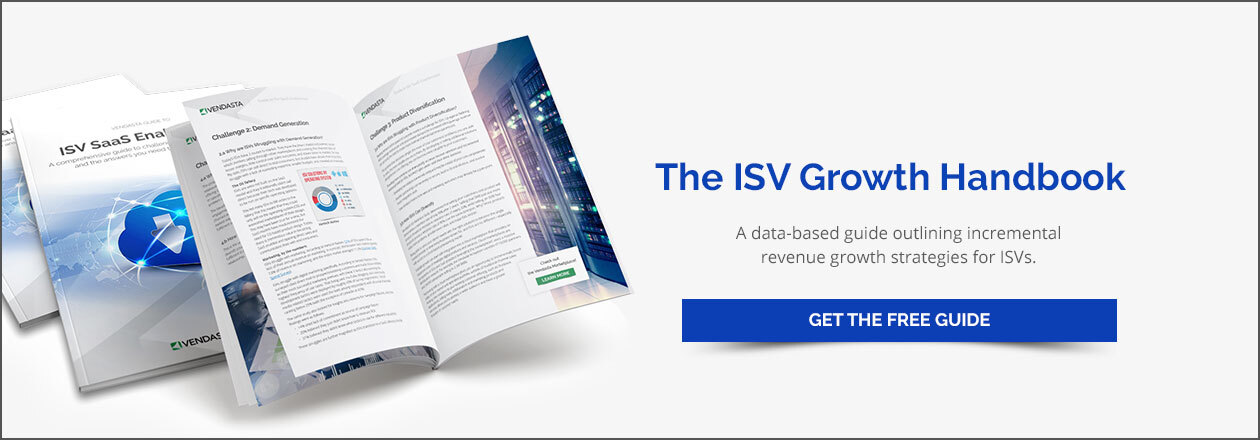But, ISVs are facing a number of challenges in the modern tech landscape. SaaS companies are evolving into sophisticated marketing agencies, marketing agencies and the like are becoming SaaS resellers, all of whom are vying for the same share of market that you are. ISVs need to revolutionize their business models and their sales channels as a means to defend their positions in the tech space.
What is an ISV?
First, let’s clear up what exactly independent software vendors are.
Conventional definition: ISVs can be defined as any technological developers who have built custom hardware or software applications for major operating systems such as IBM or Microsoft.
2019 definition: ISVs can be defined simply as any company that develops hardware or software applications.
Today, the ISV definition does not have to be bound to tech developed for a specific operating system. Today, ISV acts as an umbrella term for the likes of SaaS companies, PaaS companies, IaaS companies, software companies, hardware companies, etc.
Why is ISV Growth So Important?
ISV growth is obviously important for the nearly 200,000 ISVs in the world that depend on revenue growth to stay in business and keep their employees fed. But, ISV growth is also the cornerstone to the ongoing success and usability of most of the biggest platforms in the world.
Just think… What would Apple be without the App Store? What would Amazon Web Services (AWS) be without all of it’s solution providers? What would Google be without the Google Cloud Platform? What would WordPress be without it’s plugin library?
SaaS Enablement
It’s the biggest buzzword in the ISV landscape. SaaS enablement is the process of SaaSifying a business model. This consists of shifting from a channel partner based delivery network to that of a direct-to-consumer model. This is no small task.
Most businesses have moved away from one-time purchases and on premise implementation in favor of the SaaS model; however, the transition is not easy for ISVs. Some of the greatest challenges include custom development, service disruptions, security concerns, and establishing new billing and cash flow management systems.
But why SaaS enablement?
Put simply, it’s the model that the buyer is demanding. However, SaaS enablement serves a number of additional purposes, such as: lowering business costs through infrastructure reduction, increasing user scalability through cloud architecture, enabling live update functionality, better leveraging big data, and creating a more flexible and diversified offering to meet customer demand.
ISV Growth Strategies
If ISVs want to combat new market pressures from the likes of marketing agencies and , there are a few strategies they can deploy to generate new lines of demand, increase product appeal, and fortify customer relationships.
Here are the strategies:
1. Demand Generation
Modern ISVs have 2 routes to market; B2C and B2B marketplace models. Most ISVs are very familiar with the marketplace model, but many also suffer from the OS fallacy (I think I coined this…?), where they believe that reseller markets through the operating system (OS) of their design are the best go-to-market model. However, SaaS enablement is rapidly disrupting this belief.

Vartech Nation
But, even in switching to a SaaS model, ISVs struggle with the following:
- Experience in direct sales
- Smaller marketing budgets
- Lack of marketing knowledge and resources
- Accessing the tools needed to accurately measure ROI
It’s a marketing problem, and it’s because this is uncharted territory for most ISVs. According to Vartech Nation, 51% of ISVs spend 5% or less of their annual revenue on marketing, up against a market average of 11.2%. ISVs also explained campaign failures as being predominantly attributed to not knowing how to measure ROI, and what tactics to deploy against different industries.
ISVs need to leverage marketing automation solutions to build more intelligent sales funnels, they need more sophisticated account management software, and they need to become obsessed with delivering consumer value, through automated reporting and proof of performance tools.
ISVs need a Cloud Broker Platform.
2. Product Diversification
Customer needs have evolved, but the premise remains simple: the more of your customers’ problems you are able to solve, the more valuable you will become, the more revenue you will generate, and the lower your churn rate will become.
In fact, Vendasta’s ISV Retention Study determined that selling your customers one product will demonstrate a retention rate of only 30% after 2 years. Selling that SMB just one more product showed an increase in retention rate of nearly 20%, while selling an SMB four products proves a retention rate of 80% over the same timespan.
The answer for ISVs lies in adopting white-label products or becoming resellers of trusted products and services. White-label products are solutions that can be rebranded and sold under your name as if they were your own creation. And the benefit to selling big brand solutions is that you can quickly add a high degree of credibility to your existing offering.
3. Fulfilment
Most conventional ISVs do not have strong direct relationships with their end consumers; a byproduct of marketplace and channel selling models. This is a problem because disengaged software users churn at a rate of roughly 70%, while 90% of engaged users are generally retained.
The fastest way to foster engagement? Fulfilment models.
ISVs can create a fulfilment model via two avenues: building internal teams or outsourcing fulfilment work. Internal teams make sense for ISVs that may already have large internal support teams, while outsourced work will make more sense if you are selling/reselling any new solutions and lack expertise.
—
Download the full study to get specific strategies that ISVs can leverage to accelerate growth through business model transformation, demand generation, product diversification, and building stronger customer relationships.


 By
By 